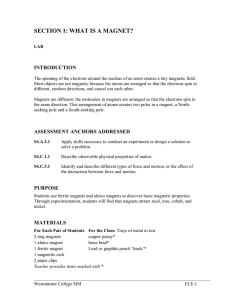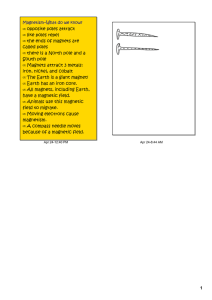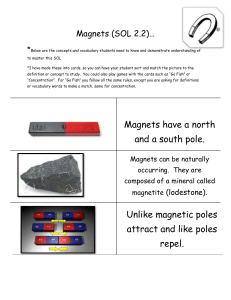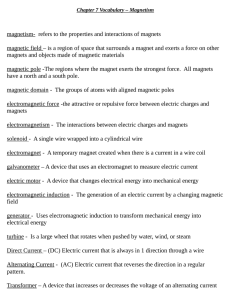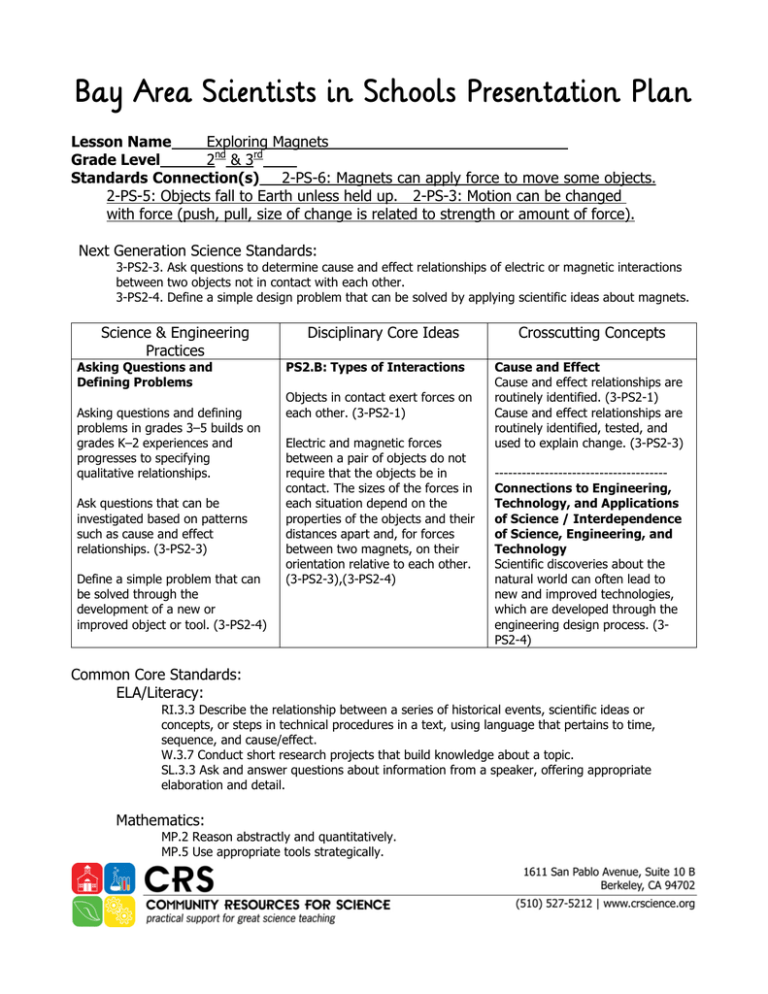
Bay Area Scientists in Schools Presentation Plan
Lesson Name
Exploring Magnets
Grade Level
2nd & 3rd
Standards Connection(s) 2-PS-6: Magnets can apply force to move some objects.
2-PS-5: Objects fall to Earth unless held up. 2-PS-3: Motion can be changed
with force (push, pull, size of change is related to strength or amount of force).
Next Generation Science Standards:
3-PS2-3. Ask questions to determine cause and effect relationships of electric or magnetic interactions
between two objects not in contact with each other.
3-PS2-4. Define a simple design problem that can be solved by applying scientific ideas about magnets.
Science & Engineering
Practices
Asking Questions and
Defining Problems
Asking questions and defining
problems in grades 3–5 builds on
grades K–2 experiences and
progresses to specifying
qualitative relationships.
Ask questions that can be
investigated based on patterns
such as cause and effect
relationships. (3-PS2-3)
Define a simple problem that can
be solved through the
development of a new or
improved object or tool. (3-PS2-4)
Disciplinary Core Ideas
PS2.B: Types of Interactions
Objects in contact exert forces on
each other. (3-PS2-1)
Electric and magnetic forces
between a pair of objects do not
require that the objects be in
contact. The sizes of the forces in
each situation depend on the
properties of the objects and their
distances apart and, for forces
between two magnets, on their
orientation relative to each other.
(3-PS2-3),(3-PS2-4)
Common Core Standards:
ELA/Literacy:
Crosscutting Concepts
Cause and Effect
Cause and effect relationships are
routinely identified. (3-PS2-1)
Cause and effect relationships are
routinely identified, tested, and
used to explain change. (3-PS2-3)
-------------------------------------Connections to Engineering,
Technology, and Applications
of Science / Interdependence
of Science, Engineering, and
Technology
Scientific discoveries about the
natural world can often lead to
new and improved technologies,
which are developed through the
engineering design process. (3PS2-4)
RI.3.3 Describe the relationship between a series of historical events, scientific ideas or
concepts, or steps in technical procedures in a text, using language that pertains to time,
sequence, and cause/effect.
W.3.7 Conduct short research projects that build knowledge about a topic.
SL.3.3 Ask and answer questions about information from a speaker, offering appropriate
elaboration and detail.
Mathematics:
MP.2 Reason abstractly and quantitatively.
MP.5 Use appropriate tools strategically.
FOSS Connections:
Grade 2 Module: Balance and Motion
Investigation 6: Magnets and Tools
Grade 3/4 Module: Magnetism and Electricity
Investigation 1: The Force
Teaser: Magnets have a special power that lets them attract other magnetic things.
Magnets can apply force to move some objects and they do this by either pulling or
pushing other objects. Today we’re going to have some fun with magnets and you’ll even
learn how to make objects float in the air!
Objective: Students will understand what magnets are and how they can use magnets apply
force on objects. Students will learn that magnetic objects have iron in them observe this
in cereal.
Vocabulary/Definitions: 3 – 6 important (new) words
- Magnet
- Force
- Attract
- Repel
Materials:
What will you bring with you?
- “Floating paper clip” jar
- Objects for sorting activity – in 8 bags
- Paper clips
- Plastic Bottle Caps
- Pennies, Nickels
- Metal Bottle Caps
- Packing Peanuts
- Corks
- Dry Pasta
- Etc
- Sorting Sheets – Magnetic & Not Magnetic x 8 sets
- Small Magnets x 8
- Total Cereal
- Neodymium Magnets (CAUTION: Read safety sheet in your kit!)
- Bar Magnets, labeled North & South x 8
- Magnetic Compasses x 30
- Diagrams of Magnets
Earth’s Magnetic Field
Atoms Inside a Magnet
- Exploring Magnets Worksheets
- Ring Magnets
- Pencil
- Paper for Magnetic Field Tracing Activity x 8 (replace for each lesson)
What should students have ready?
- Students should have their own pencils and an inquisitive mind.
Classroom Set-up:
Students should be seated in groups of 3 or 4.
Classroom Visit
1. Personal Introduction:
__5__ Minutes
Introduce yourself and what you do at Bayer. Talk about what you love about science,
your favorite scientific activity, your favorite non-scientific activity, and why and how you
got into your career.
Today we brought with us a “magic” jar – watch what it can do. [Now show the kids the
jar with the paper clip lying at the bottom of the jar. Place the lid on the jar and turn it
upside down so that the paper clip hangs from the string. Carefully turn the jar right
side up so that the paper clip is being pulled by the magnet.] Wow! How is it doing
that? It’s actually not magic – it’s science. Today we’re all going to be scientists, and
we’ll be doing some experiments to see if we can figure out how this “magic” jar works.
2. Topic Introduction:
__5__ Minutes
What questions will you ask to learn from students? Big Idea(s), vocabulary, assessing
prior knowledge…
Who here has used a magnet before? Where was it? On your refrigerator?
you use the magnet for? What did you notice about the magnet?
What did
Magnets stick to things that are magnetic, like your refrigerator. Today we are all going
to try to discover as much about magnets as we can. We already know that magnets stick
to refrigerators, but what else do they stick to? And what don’t they stick to?
3. Learning Experience(s):
___40____
Minutes
Activity #1: Magnets versus Non-Magnets
What makes something magnetic? Now we’re going to be scientists and make
some hypotheses or predictions about which of these objects are magnetic. Now you are
going to sort through the objects in the bag with your group members and place them in
the appropriate category based on your hypothesis. If there are any objects that the
group is unsure about, set them aside and we will talk about them with the rest of your
class.
Pass out bags of objects for testing and laminated sheets marked MAGNETIC and
NOT MAGNETIC but do not pass out magnets yet.
Walk around during this time to listen to the discussions at each table. After about 10
minutes, get the students’ attention. Ask for the teacher’s help if you need it.
Were there were any objects they were unsure about. What about in other groups? Which
category did your group put it in? Why did you choose to put it there?
Did you notice any patterns about the objects that are magnetic or non-magnetic. For
example, did you put all the metal objects in the Magnetic column, why or why not?
Give each group of students their testing magnets. Have them test each one of the
objects to see if they stick to the magnet.
After they’ve had a chance to test all their objects (about 5 minutes) get the student’s
attention.
Review: Was anyone surprised? Why or why not?
Explanation for Activity #1:
Well, actually things that are magnetic generally have a metal called iron in them. There
are lots of different kinds of metals and iron is just one kind. Where else have you heard
of iron before? Do you know what else has iron in it?
While one person is leading the discussion, another person can set up the Magnetic
Cereal activity on one side of the room. To save time, you may also wish to do the
magnetic cereal demonstration while students are sorting their objects.
Set up for Magnetic Cereal: Place a little bit of water in the shallow tray. Right
before the students come up to the station place a dry piece of Total Cereal on top of
the water. You may need to replace the flake with a new one periodically.
Activity #2: Magnetic Cereal
One thing you might not realize has iron in it is YOU! Your bodies actually have lots of iron
in them in your blood and you need the iron to help keep you strong. The body contains
enough iron for two small nails, and it is essential for the production of hemoglobin.
Where do you think the iron in your body comes from?
It comes from the foods you eat. Some foods actually have iron added to them to make
you strong and healthy like this cereal (hold up the Total Cereal Box).
Now we’re going to do an activity that will show you that there’s iron in this cereal.
Ask the students to put all of their materials back into the bags.
When the first group has put everything back in their bags, please raise your hands and
sit quietly. Your teacher/one of us will call you up. Bring your bags, sorting sheets, and
magnets up to [this person] so we can put it away. Then, line up quietly.
Call students up one by one. Have an adult guide the student in moving the cereal
grains around the water using the Neodymium magnet. Once the student has had
their turn they should return to their seats.
Activity #2: Explanation
Let’s talk about what we saw just now. We saw that magnets will stick to some objects
but not others and that some of the food we eat also have iron in them.
‘Special K’ packets quote 20 mg of iron per 100 g of cereal. Products such as
cornflakes, which are fortified at a lower level, have about 6 - 7 mg of iron per 100 g,
while un-fortified breakfast cereals have 1 – 2 mg of iron per 100 g. “Total” cereal
has about 40 m g of iron per 100g of cereal.
The “stickiness” that you feel is actually a force called magnetism. Where have you heard
the word “force” before? Can anyone tell me what a force is?
A force is a push or pull. When a magnet “sticks” to something, it is actually pulling on
it. But wait…if I pull on something – like my friend – he moves. So if the magnet on your
fridge is pulling on the fridge, why isn’t the fridge moving? [Let the kids offer ideas about
why the fridge isn’t moving]
The magnet is too weak and the fridge is too heavy. It’s like if I tried to pull on the
school – I’m exerting a force, but I’m too weak and the school is too heavy, so it doesn’t
move. But if a magnet is strong enough or the thing it’s pulling on is light enough, a
magnet can be used to move things.
Now that we’ve seen that magnets sometimes stick to things, we’re going to show you
something else that magnets can do.
Activity #3: North and South Poles (Optional)
Place 2-ring magnets on a pencil so that one floats on top of the other. If they don’t
float then flip one of them over. Then say:
Notice how one magnet is floating above the other one. What do you notice when you try
and push down on the top magnet?
Walk around the class and ask students to push down on the top magnet.
When you try to push the magnets together you feel a push back because the magnets
are “repelling” each other. When we reverse the direction of the magnets (reverse the
magnets) they “attract each other.
We’re going to do an experiment now that explains why this happens.
While one person is walking around with the ring magnets, have the teacher help you
rearrange the students into 4 groups and pass out worksheets. As the students to
make predictions in the (A) questions on the worksheet. Once everyone has had a
chance to try the ring magnets and is sitting down, pass out the bar magnets and
have them try to fill out their worksheets.
One person can start cleaning up. If you have a lot of time leftover – SEE OPTIONAL
ACTIVITY
4. Wrap-up: Sharing Experiences
____5_____ Minutes
Remember my “magic jar” from earlier? Let’s look at it again. Now that you have seen
magnets in action, do you have any ideas about how it might work? [Demo the “magic
jar” again”] There is actually a magnet inside the lid of the jar that’s pulling on the paper
clip. It wants to pull the paper clip all the way up to the top of the jar, but the string is
holding onto the paper clip and stopping it – the string is also exerting a force! So you
see, the jar wasn’t magic at all, it was science!
So what did we learn about magnets today? What is a force? What is the special force
that magnets have called? What kinds of things do magnets pull on? What kind of
things can they push on?
5. Connections & Close:
____5_____
Minutes
The magnets on your fridge at home aren’t strong enough to move the fridge, but there
are super-strong magnets out there that could easily move the fridge all the way across
the floor. Did anyone see the movie “Toy Story 3”? Do you remember when the toys
are at the landfill, riding on the conveyor belt, and then they grab onto something metal
and get pulled up to the ceiling? That’s a magnet – magnets are used to sort garbage.
Magnets are also used in elevators, credit cards, electric toothbrushes, refrigerators, and
your TV! And they’re used in roller coasters…has anyone ever been on a rollercoaster?
What do you think a magnet does in a roller coaster?
We have to collect your magnets now, but there are magnets everywhere that you can
use to experiment with pushing and pulling. Why don’t you see what else you can do
with magnets, and then write us a letter letting us know what cool things you’ve done?
Total 50 – 60 Minutes
Differentiated Instruction:
English Learners: Repeat directions, if necessary, and physically model how to use
magnets. Write vocabulary, e.g. magnets, force, on the board and read words aloud.
Vocabulary words can also be visually demonstrated, e.g. using an illustration, and/or
redefined in very simplistic terms.
Advanced Learners: Have students experiment with magnets and make observatory
notes about what materials magnets are attracted to and not attracted to.
Optional Activity: Tracing Magnetic Field Lines
Does anyone know what a compass is and what you use them for? (Show them a compass) It
helps you find you way when you’re lost. To be more accurate, a compass helps you find
“North”. If you were lost and you followed the compass point from here, you might eventually
end up in Canada or Alaska and if you go in the opposite direction as the compass point you
could walk all the way to Mexico in the south.
The reason a compass works is because the earth is actually one giant magnet. Show the
diagram “Earth’s Magnetic Field”, see the North and South sides of the Earth. Smaller magnets
also have a North and South side and we’re going to do an experiment to see it.
In science when we say something has a “magnetic field” we mean that whenever another
magnet gets close it will be pulled or pushed. We can use the compass to see which way the
other magnet will be pushed or pulled.
In your groups, we’re going to pass out a sheet of this large paper and a big bar magnet. As
you can see each side is a different color, what do you think these colors represent? That’s right,
one represents the North and the other is South.
For this activity we are going to find out which side is north by using our compass. Before we
pass out the materials, let’s go over the directions:
1.
2.
3.
4.
5.
6.
7.
Have an adult help you tape your paper and your magnets to the table.
Draw a dot someplace on your paper near the magnet.
Place your compass on the dot.
Wait until the compass needle stops moving.
Draw another dot where the arrow tip is pointing.
Connect the dots and draw an arrow in the same direction the compass was pointing.
Move the compass to the tip of the arrow and repeat steps 5 and 6 until you hit either
the magnet or the edge of your paper.
8. Draw another dot and continue until we run out of time.
Help each group tape the paper to the table or desk. Then,
tape the magnet to the center of the paper.
Pass out a compass to each student and let them trace
magnetic field lines for 10 minutes. Get the students
attention and ask them to put their pencils down.
What did you notice about the magnetic field lines? What did
they look like?
Draw the above diagram on the board. Call a student up to draw what their group’s field
lines look like, ask the teacher for help choosing a student.
Did everyone’s paper looks like this? Raise your hand if you had something different. You can
come up and show us what your magnetic field lines look like.
Follow-up Possibilities
ELA Activity:
-Have the kids write a letter describing other uses (and potential) uses for magnets.
Reading Connections:
- Awesome Experiments in Electricity and Magnetism by Michael
DiSpezio http://www.amazon.com/Awesome-Experiments-Electricity-MagnetismDiSpezio/dp/1402723709
- Electricity and Magnetism by Sarah Angliss http://www.amazon.com/ElectricityMagnets-Hands-Science-Angliss/dp/0753453495
- What Magnets Can Do? (Rookie Read About Science) by Allan
Fowler http://www.amazon.com/What-Magnets-Rookie-Read-AboutScience/dp/051646034X
- Magnets: Pulling Together, Pushing Apart by Natalie M.
Rosinsky http://www.amazon.com/Magnets-Pulling-Together-PushingAmazing/dp/1404803335/
- What Makes a Magnet by Franklyn M. Branley http://www.amazon.com/MakesMagnet-Lets-Read-Find-Out-Science/dp/0064451488
Mathematics Activity:
-Have students count, record, and graph the number and kinds of magnets they
find in and around their homes.
Other:
Pulling iron out of breakfast cereal
activity: http://www.stevespanglerscience.com/experiment/00000034
Magnetic
NOT
Magnetic
Name(s)_____________________________________________________________________________
Exploring Magnets: North & South Pole Worksheet
Directions: Circle your answers.
When I place magnets like this:
attract means to pull closer.
repel means to push away.
I predict that they will… The magnets actually…
attract
OR
repel
attract
OR
repel
attract
OR
repel
attract
OR
repel
attract
OR
repel
attract
OR
repel
WWW.ARBORSCI.COM
Neodymium Magnets
P8-1123
BACKGROUND:
The magnets in your possession are some of the most powerful magnets in the world. They are
made out of a neodymium-iron-boron material, or Nd2Fe14B, of which iron is the main component.
Their field strength has been measured at 12.5 kiloGauss, or 1.25 Tesla (tens of thousands of times
stronger than the earth’s magnetic field). Their incredible strength makes them a constant source of
wonder as well as ideal demonstrators of the force of magnetism in traditional, and some not so
traditional, experiments. As you may already know, these are not ordinary magnets and cannot be
handled as such - please read the cautionary notes below.
PRECAUTIONS:
•
Never allow the two magnets to come together abruptly! The attraction is so strong that the
magnets may chip or break, launching tiny chips into the air!
•
Take care that your finger or a sensitive fold of skin does not get caught between this magnet
and another. A blood blister or minor abrasion could result.
•
Never allow the magnets near computer disks, recording tapes of any kind, credit cards,
bank cards, or any other device which uses magnetic material to record information.
•
It is very difficult to separate the two magnets by hand. Separate them by sliding them apart
rather than by a direct pull.
•
Storage is not a problem (no keeper is needed), but do not store near magnetically sensitive
materials.
•
Do not heat the magnets over 150oC. They will lose some of their magnetism permanently.
PO Box 2750
ANN ARBOR, MI 48106 T 800-367-6695
WWW.ARBORSCI.COM
©2012 ARBOR SCIENTIFIC ALL RIGHTS RESERVED
ACTIVITIES:
Place one of the magnets on the back of your hand and the other on your palm. The attraction is
strong enough to prevent either magnet from falling. Turn your hand palm-side downward and turn
over the lower magnet. Reversing field will repel the upper magnet, making it turn over as well. Take
care that the two magnets do not seek each other out around the edge of your hand!
1. Test the magnet on substances you “know” are not magnetic-pencils, crayons, aluminum foil,
bits of clay, paper, and anything else you can think of. See what happens when one of the
magnets is brought close to a dollar bill. Can you think of a way to determine whether the
attraction is from the printing ink or the paper itself? Could you if it weren’t your dollar?
2. Obtain a straight copper tube 3/4 inch in diameter and about 2-3 feet in length. Holding the
tube vertically, observe the magnet drop through the tube. Then try it with 2 joined magnets.
Can you explain the resulting phenomenon? (Hint: remember Hans Oersted’s discovery of
1820 and what Joseph Henry and Michael Faraday independently demonstrated in 1832.
Lenz’s law is most often referred to in context of this experiment.)
3. Gently roll a magnet across a wooden table. It should align itself with the earth’s magnetic
field.
4. Test the “lead” (graphite) of a mechanical pencil for magnetism. Balance the graphite on a
nonmagnetic item and observe whether the graphite is attracted or repelled by the magnet.
5. Move the magnet across a plate of aluminum. Vary the speed and force you apply to the
magnet. The opposing force will amaze everyone. Next, try rolling the magnet down the
plate at an incline. What happens when it reaches the edge?
6. Set up a rotating balance apparatus. A pin mounted on the center of a wire (try a section of
coat hanger) works well. Then balance the point of the pin on top of an upside down cup so
that the “arms” (the wire) can rotate around the pivot. Pull the ends of the wire down below
the pivot point so that the center of gravity makes it easier to balance. Test for
“diamagnetism” in food. Stick a grape on each end of the wire (more balancing may be
required). Use both magnets stacked to repel the grapes (the balance will rotate.) Notice
that both poles repel the grapes.
PO Box 2750
ANN ARBOR, MI 48106 T 800-367-6695
WWW.ARBORSCI.COM
©2012 ARBOR SCIENTIFIC ALL RIGHTS RESERVED

